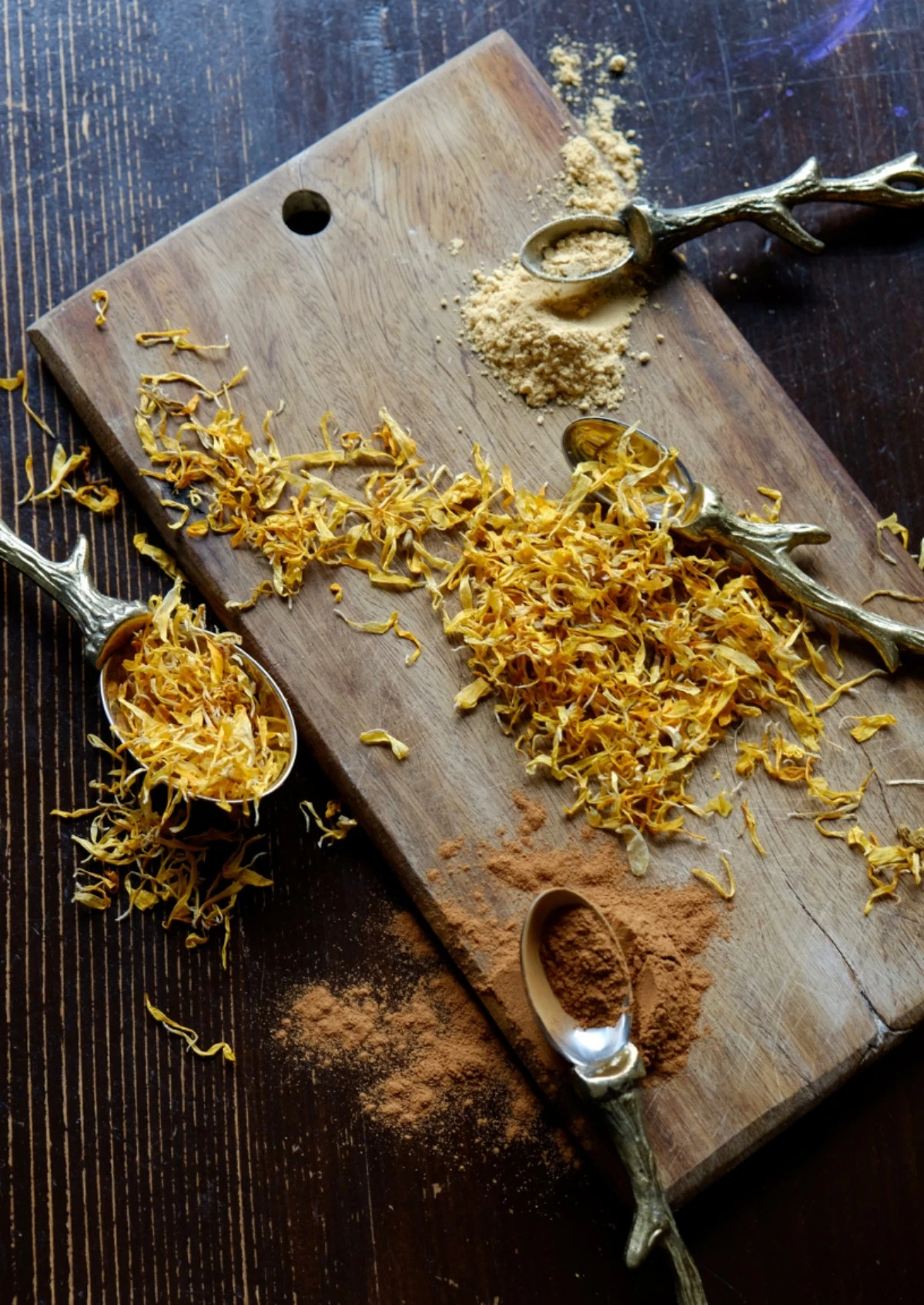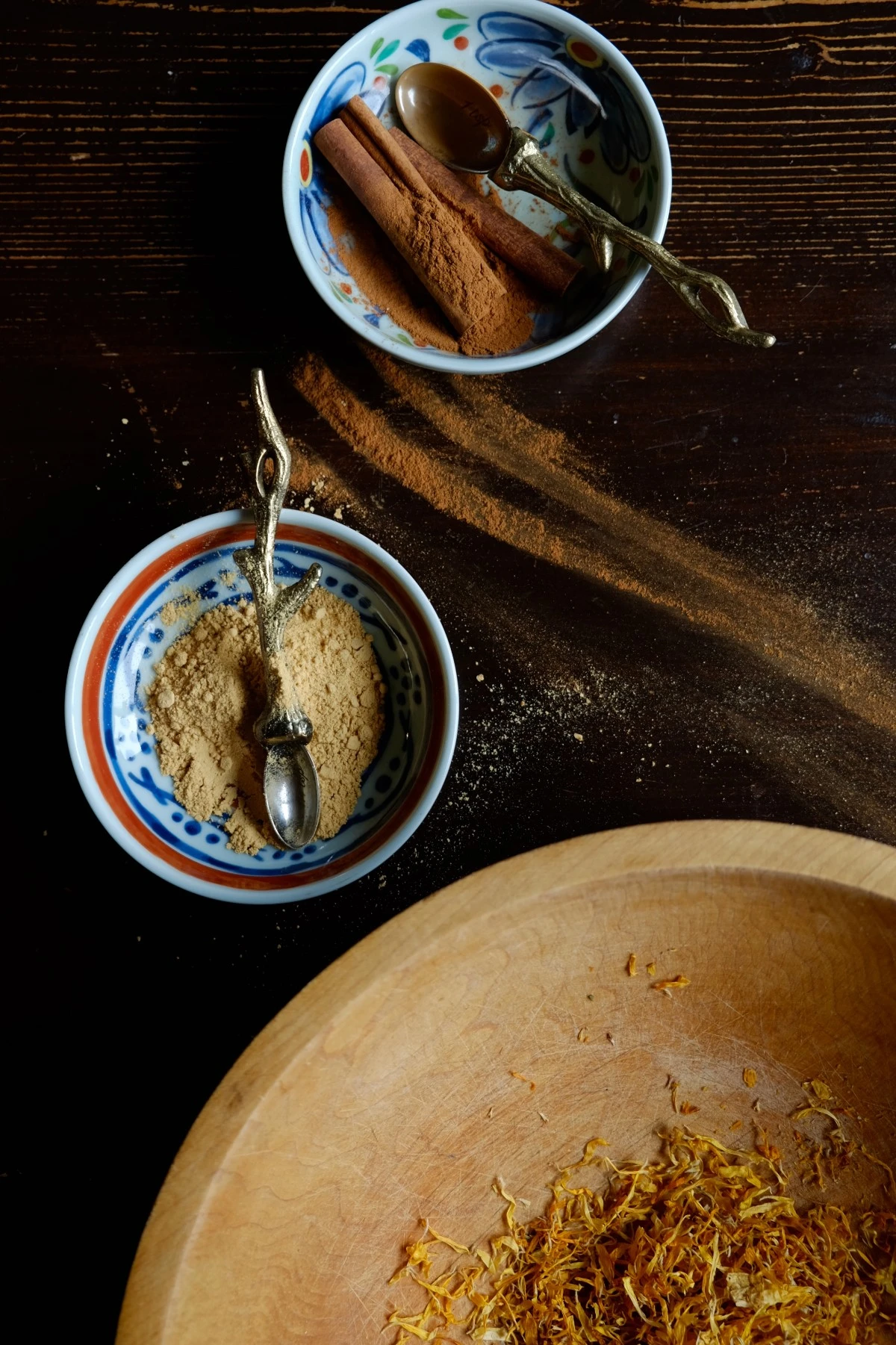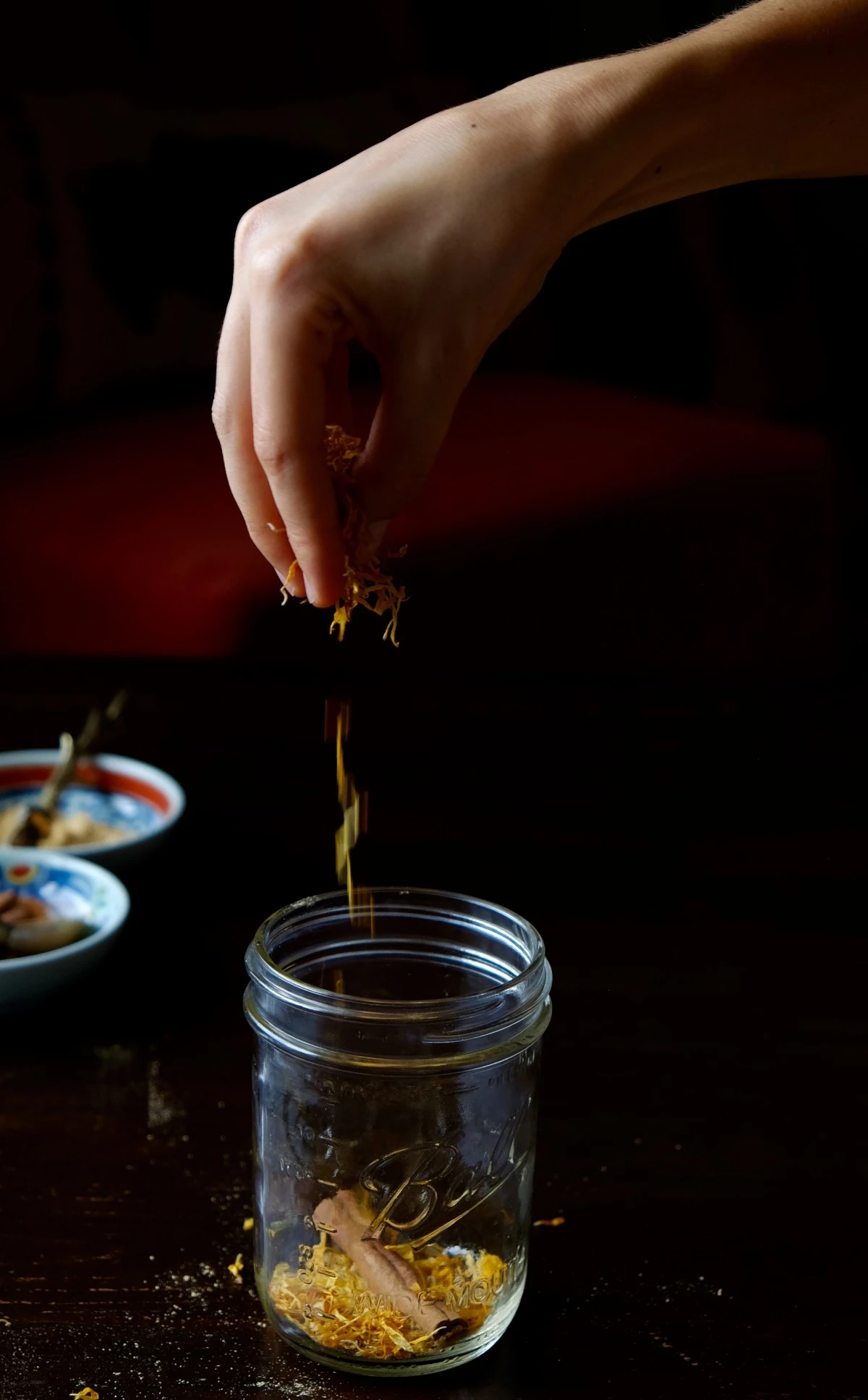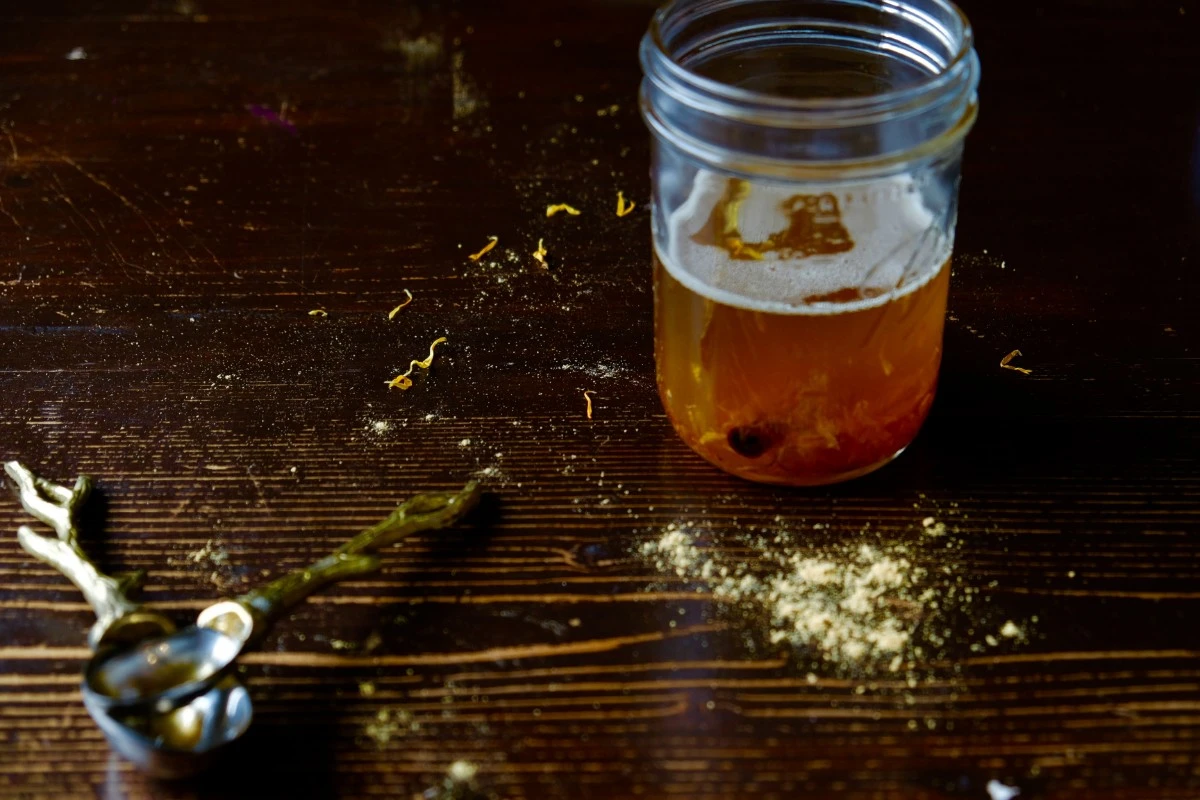invigorating sesame ginger oil

I always know Fall has arrived when I begin to itch and scratch. From head to toe my scalp, fingers, arms and legs become dry and flaky for what seems almost no reason at all. I have all but begun to accept the fact that each year I will have to slather myself in oils and include more fats into my diet as the seasons shift.
As both Ayurveda and Traditional Chinese Medicine observe, Fall is a season of transition. The element Air is at its peak and we are more vulnerable to effects of dryness and wind, from colds and flus, dry skin, and others.
While everyone is influenced by the seasons and elements in different ways and should adjust their diets and lifestyles accordingly, we tend to be particularly sensitive to the seasons that are in line with our prevailing dosha, or personal elemental constitution.
The doshas and their descriptions:
Vata – (air, ether) – associated with the season Winter.
Descriptives: dry, light, cold, rough.
Pitta – (fire, water) – associated with the season Summer.
Descriptives: slightly oily, hot.
Kapha – (water, earth) – associated with the season Spring.
Descriptives: oily, cold, heavy, slow, smooth, slimy, static.
During Fall and Winter, whether we live in California or Maine, or are characteristically Vata or another dosha, we may notice changes in our muscles, joints, nervous system, and skin and hair. Bottom line, as the seasons shift our routines and diets needs to as well. If you are a predominantly Vata like Rachael and me, learning to make your own soothing and moisturizing infused oils can save your skin in these coming cold and dry Fall and Winter months.
This oil infusion recipe has the added benefit of being warming and invigorating to the skin and muscles; relieving tired, sore or even sprained muscles; and helping to tone the texture and elasticity of the skin by improving circulation as well. It can even be used on the scalp to help stimulate hair growth.
What are herb-infused oils?
An oil infusion is an extraction of any medicinal or culinary herb in a fixed oil menstruum. A menstruum is simply the solvent used to prepare extracts. Common menstruums used in Herbalism practices are water, alcohols, vinegars, glycerin and oils. Infusions for culinary purposes are common and are usually prepared in water (think tea and coffee), oils, vinegars, and alcohols – even wine! For our purposes we will be creating an infused herbal oil to be used topically.
Most plants contain many beneficial healing properties plus delicate oils and nutrients that can be extracted through different processes. Not to be confused with essential oils, which are the concentrated essence of the plant’s natural oils, infused oils are made by steeping the plant material into a lipid or oil for a period of time, eventually infusing the carrier oil with the medicinal properties of that plant. The oil acts as a solvent and extracts the properties of the herb or plant which can then be used for medicinal, culinary, and bath and beauty purposes. Unlike essential oils, they are very easy to make and much more gentle on the skin.

Sesame oil
Many different types of oils can be used for an oil infusion, and often the type of oil used will also provide specific benefits. Sesame oil is known for its warming and medicinal properties. It is incredibly soothing and can be used to repair damaged and aging skin cells and to calm irritated, inflamed skin. It has been used internally and externally both for medicinal and culinary purposes for centuries in Ayurvedic practices to support the nervous system, ease stress, and nourish the muscles and bones. It is especially therapeutic for reducing overly Vata characteristics. Sesame oil also contains anti-bacterial properties and natural sunscreen properties.
Cinnamon
Originating in tropical Asia, this spice is now grown in almost every tropical region around the world. Nutritionally, cinnamon provides a wide range of benefits and has been used to treat everything from diarrhea to colds and flus, arthritis, balancing blood sugar, and easing menstrual cramps. This is largely due to cinnamon’s astringent, anti-bacterial, anti-fungal, and anti-clotting properties as well as its high essential mineral content.
In general, cinnamon is excellent at improving circulation as well as reducing pain, both if taken internally or used externally.
In a concentrated form, it can be irritating to the skin, so it is recommended to use it in its whole, herb form, rather than as an essential oil. Also, test a small area of the skin to see how it will affect you first, and never use on the face.
Ginger
Ginger is another herb that should be recognized for its amazing therapeutic benefits. Also commonly used in Ayurveda, ginger has been used to treat colds and flu, digestive issues and nausea, and muscle and joint aches and pains. It is warming and energizing in nature and can be used on the skin to help circulation, stimulate hair growth, reduce dandruff, and even help to dull marks and scars. Like cinnamon, ginger is quite potent, so make sure you test a small area of the skin before using.
Calendula flowers
Also more commonly known as pot marigolds, calendula flowers are one of the most used herbs in topical treatments to soothe the skin. Slightly antibacterial, these flowers help provide relief to inflamed and damaged skin or cuts. They can soothe rashes and other skin issues such as dermatitis, eczema, and psoriasis, making calendula a perfect herb to include in our soothing sesame oil to help balance out some of the more stimulating effects of ginger and cinnamon.
How to make solar infused oils:
Sesame oil is delicate because of its high percentage of polyunsaturated fatty acids and can break down at high heat, so for this infused oil we recommend the solar infusion process, which also happens to be the simplest process.

What you will need:
1, 16-ounce Mason jar with tight fitting lid
parchment or wax paper
a paper bag
unbleached paper coffee filter
cheesecloth
amber bottle
1 stick organic cinnamon
1/2 teaspoon powdered organic ginger
2 tablespoons dried calendula flowers
8 ounces or more of unrefined cold-pressed organic sesame oil
1. Make sure your herbs are dried before using. The greater the surface area (smaller pieces yield a greater total surface area), the better. If you can source powdered herbs, that is preferred (with the exception of cinnamon). If not, then just be sure to chop or process your herbs into small pieces.
2. Place all measured herbs in a very clean and sterilized Mason jar.
3. Pour oil into the jar, covering the herbs with at least an inch of the oil and be sure to also leave at least one inch of space at the top of the jar to allow for expansion. If your herbs soak up all the oil you can always add more until the herbs are completely immersed, so check back with your herbs a few hours later in case you need to add more oil to the jar.
4. Stir well. If your jar has a metal lid, add a piece of parchment paper between the lid and the jar to prevent rusting. Seal tightly.
5. Place the jar in a sunny area of your house, like a windowsill, and shake or agitate daily. To protect the delicate properties of the oil while the solar infusion takes place, make sure to put the Mason jar inside of a paper bag or use dark UV protected glass. This will allow the gentle heat to infuse the oil while preserving the integrity of the sesame oil.
6. In about a month or two, depending on the desired potency, strain the oil through cheesecloth. Allow the oil to sit overnight and you may see you need to strain further sediment using a coffee filter. Make sure you strain as much oil as you can from the herbal solution.
7. Pour into a glass bottle and store in a cool, dark place. Amber bottles are ideal for this since they do not allow light though the glass, preventing the oxidation of the oil. Storing the oil in the refrigerator is also a great method of extending the life of the oil.
The oil should keep for about 6-12 months if stored properly.
Use as needed for massaging sore muscles, aches, pains, healing dry skin, to promote circulation, or use on the scalp as a treatment to prevent dandruff and promote hair growth.
Remember to test your sensitivity to the oil, and if using on hair and scalp, wash off after 20 minutes.

[…] circulatory and even antibacterial properties. Check out how to make your own massage oil here, or, if you would prefer to purchase it already made, try The Organic Pharmacy’s Detox Body […]
[…] circulatory and even antibacterial properties. Check out how to make your own massage oil here, or, if you would prefer to purchase it already made, try The Organic Pharmacy’s Detox Body […]
[…] circulatory and even antibacterial properties. Check out how to make your own massage oil here, or, if you would prefer to purchase it already made, try The Organic Pharmacy’s Detox Body […]
[…] even antibacterial properties. Check out the best way to make your personal therapeutic massage oil hereor, in the event you choose to purchase it already prepared, strive it The organic pharmacy detox […]